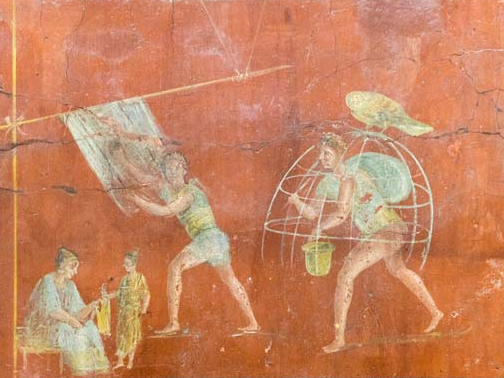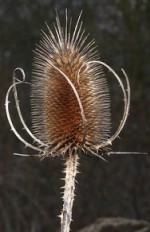
This herbaceous biennial is native to damp grassland and woodland areas in Eurasia and North Africa and is a member of the honey suckle family, Caprifoliaceae, that also includes weigela, scabiosa, and abelia. It grows in present time in the archeological areas of Pompeii and may have grown there in 79 AD. The ancient Greek pharmacologist, Dioscorides (d. 90 AD), gives medicinal uses of teasel for the treatment of intermittent fevers, and anal fissures and fistulas. The ancient Roman naturalist, Pliny the elder (d. 79 AD) tell us that the “worms” inside the flower heads ( the larvæ of the Curculio or weevil) can be used to treat teeth problems. Another use of the plant, however, was by fullers who used the brickly flower heads to raise the nap of wool cloth. The existence of 11 fullonicae and numerous graffiti associated with fullers testify to the presence of fulleries in ancient Pompeii and scholars believe that they used teasel in the cleaning and finishing of wool cloth.

Description: In the first year the plant grows a tap root and forms a rosette of large coarse lanceolate leaves up to 12″ long. In the second year several spiny stems up to 6’ tall arise bearing sessile spiny leaves and clusters of spiny flowerheads from summer into fall. Each egg-shaped flowerhead is up to 4″ long and consists of numerous small pink, purple or lavender flowers, subtended by long pointed bracts. The flowerheads produce an abundance of 1 seeded fruits, called achenes, that have a high germination rate so plants readily reproduce themselves and may become weedy. Butterflies and bees love the flowers, birds, especially goldfinches love the seed, and the dried seed heads look fabulous in dried arrangements.
Light: Full sun to part shade
Size: 4-6′ H x 1-2.5′ H
Soil: Moderately fertile, medium moist, well-drained
Hardiness: Zones 3-8